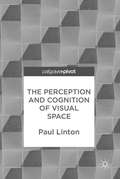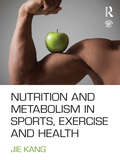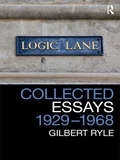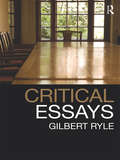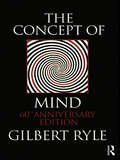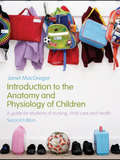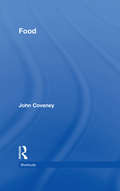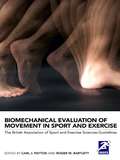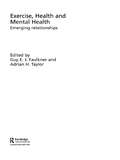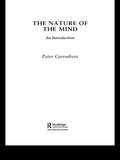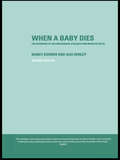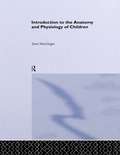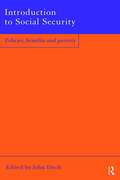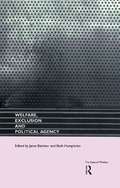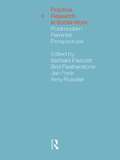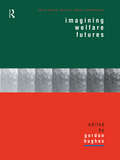- Table View
- List View
The Perception and Cognition of Visual Space
by Paul LintonThis book explores a central question in the study of depth perception - 'does the visual system rely upon objective knowledge and subjective meaning to specify visual depth?' Linton advances an alternative interpretation to the generally accepted affirmative answer, according to which many of the apparent contributions of knowledge and meaning to depth perception are better understood as contributions to our post-perceptual cognition of depth. In order to defend this position a new account of visual cognition is required, as well as a better understanding of the optical and physiological cues to depth. This book will appeal to students and researchers in psychology, vision science, and philosophy, as well as technologists and content creators working in virtual and augmented reality.
Nutrition And Metabolism In Sports, Exercise And Health (PDF)
by Jie KangA key determinant of successful athletic performance is the high-level energy transformation which begins with combustion of the food that we eat. By developing a sound understanding of good nutrition we can improve athletic performance, help maintain good health and prevent disease. This clear and comprehensive introduction to nutrition in sport, exercise and health goes further than any other textbook in integrating key nutritional facts, concepts and dietary guidelines with a thorough discussion of the fundamental biological science underpinning our physiological and metabolic processes. By clearly explaining how nutrients function within our biological system, the book helps students to develop a better understanding of the underlying mechanisms, which, in turn, will help the student to apply their knowledge in practice. The book includes in depth discussion of key contemporary topics within nutrition including: nutrient bioenergetics nutrition and metabolic disease nutritional ergogenic aids nutrition for special populations nutritional assessment. Each chapter includes useful pedagogical features, including case studies, review questions, definitions of key terms, and practical laboratory exercises #65533; such as techniques for assessing nutritional status, body composition and physical activity patterns. A companion website offers additional teaching and learning features, such as PowerPoint slides, multiple-choice question banks and web links. As the most up-to-date introduction to sport and exercise nutrition currently available, this book is essential reading for all students of sport and exercise science, kinesiology, physical therapy, nutrition, dietetics or health sciences. Visit the companion website at www. routledge. com/cw/kang
Nutrition And Metabolism In Sports, Exercise And Health
by Jie KangA key determinant of successful athletic performance is the high-level energy transformation which begins with combustion of the food that we eat. By developing a sound understanding of good nutrition we can improve athletic performance, help maintain good health and prevent disease. This clear and comprehensive introduction to nutrition in sport, exercise and health goes further than any other textbook in integrating key nutritional facts, concepts and dietary guidelines with a thorough discussion of the fundamental biological science underpinning our physiological and metabolic processes. By clearly explaining how nutrients function within our biological system, the book helps students to develop a better understanding of the underlying mechanisms, which, in turn, will help the student to apply their knowledge in practice. The book includes in depth discussion of key contemporary topics within nutrition including: nutrient bioenergetics nutrition and metabolic disease nutritional ergogenic aids nutrition for special populations nutritional assessment. Each chapter includes useful pedagogical features, including case studies, review questions, definitions of key terms, and practical laboratory exercises #65533; such as techniques for assessing nutritional status, body composition and physical activity patterns. A companion website offers additional teaching and learning features, such as PowerPoint slides, multiple-choice question banks and web links. As the most up-to-date introduction to sport and exercise nutrition currently available, this book is essential reading for all students of sport and exercise science, kinesiology, physical therapy, nutrition, dietetics or health sciences. Visit the companion website at www. routledge. com/cw/kang
Collected Essays 1929 - 1968: Collected Papers Volume 2
by Gilbert RyleGilbert Ryle was one of the most important and yet misunderstood philosophers of the Twentieth Century. Long unavailable, Collected Essays 1929-1968: Collected Papers Volume 2 stands as testament to the astonishing breadth of Ryle’s philosophical concerns. This volume showcases Ryle’s deep interest in the notion of thinking and contains many of his major pieces, including his classic essays ‘Knowing How and Knowing That’, ‘Philosophical Arguments’, ‘Systematically Misleading Expressions’, and ‘A Puzzling Element in the Notion of Thinking’. He ranges over an astonishing number of topics, including feelings, pleasure, sensation, forgetting and concepts and in so doing hones his own philosophical stance, steering a careful path between behaviourism and Cartesianism. Together with the Collected Papers Volume 1 and the new edition of The Concept of Mind, these outstanding essays represent the very best of Ryle’s work. Each volume contains a substantial preface by Julia Tanney, and both are essential reading for any student of twentieth-century philosophies of mind and language. Gilbert Ryle (1900 -1976) was Waynflete Professor of Metaphysics and Fellow of Magdalen College Oxford, an editor of Mind, and a president of the Aristotelian Society. Julia Tanney is Senior Lectuer at the University of Kent, and has held visiting positions at the University of Picardie and Paris-Sorbonne.
Critical Essays: Collected Papers Volume 1
by Gilbert RyleGilbert Ryle was one of the most important and controversial philosophers of the Twentieth century. Long unavailable, Critical Essays: Collected Papers Volume 1 includes many of Ryle’s most important and thought-provoking papers. This volume contains 20 critical essays on the history of philosophy, with writing on Plato, Locke and Hume as well as important chapters on Russell and Wittgenstein. It also includes three essays on phenomenology, including Ryle’s famous review of Martin Heidegger’s Being and Time first published in 1928. Although Ryle believed phenomenology ‘will end in self-ruinous subjectivism or in a windy mysticism’ his review also acknowledged that Heidegger was a thinker of great originality and importance. While surveying the developments in the philosophy of language and philosophical logic, Ryle sets out his own conception of the philosophers’ role against that of his predecessors and contemporaries. Together with the second volume of Ryle’s collected papers Collected Papers Volume 2 and the new edition of The Concept of Mind, all published by Routledge, these outstanding essays represent the very best of Ryle’s work. Each volume contains a substantial introduction by Julia Tanney, and both are essential reading for any student of twentieth-century philosophies of mind and language. Gilbert Ryle (1900 -1976) was Waynflete Professor of Metaphysics and Fellow of Magdalen College Oxford, an editor of Mind, and a president of the Aristotelian Society. Julia Tanney is Senior Lecturer at the University of Kent, and has held visiting positions at the University of Picardie and Paris-Sorbonne.
The Concept of Mind: 60th Anniversary Edition
by Gilbert RyleFirst published in 1949, Gilbert Ryle’s The Concept of Mind is one of the classics of twentieth-century philosophy. Described by Ryle as a ‘sustained piece of analytical hatchet-work’ on Cartesian dualism, The Concept of Mind is a radical and controversial attempt to jettison once and for all what Ryle called ‘the ghost in the machine’: Descartes’ argument that mind and body are two separate entities. This sixtieth anniversary edition includes a substantial commentary by Julia Tanney and is essential reading for new readers interested not only in the history of analytic philosophy but in its power to challenge major currents in philosophy of mind and language today.
Introduction to the Anatomy and Physiology of Children: A Guide for Students of Nursing, Child Care and Health
by Janet MacGregorFully updated, this new edition provides an introduction to normal, healthy physical development for all professionals who specialise in working with children. The author, an experienced nurse teacher, guides the reader through the key changes in body systems and functions from embryo to birth through childhood and adolescence. Chapter 1 sets the scene for physical needs in child development, such as the need to be warm and safe. Chapters 2 to 9 cover the body systems: skeletal; nervous; cardiovascular; respiratory; renal; digestive; reproductive; and immune. The embryology and physiological function at birth is explored in each chapter before the text moves on through the many changes over the next decade to puberty and the arrival at adult functioning. A new final chapter provides a holistic account of children’s development, body and mind. Each chapter is illustrated with line drawings and tables, and ends with scenarios which illustrate how knowledge supports good practice in a real-life situation, and a quiz to consolidate learning. Concise and clearly written, this introductory text will be essential reading for all those working with children and families in the health and social care sector, enabling them to ensure children enjoy a safe and healthy childhood in line with Every Child Matters and new national service framework directives.
Introduction to the Anatomy and Physiology of Children: A Guide for Students of Nursing, Child Care and Health
by Janet MacGregorFully updated, this new edition provides an introduction to normal, healthy physical development for all professionals who specialise in working with children. The author, an experienced nurse teacher, guides the reader through the key changes in body systems and functions from embryo to birth through childhood and adolescence. Chapter 1 sets the scene for physical needs in child development, such as the need to be warm and safe. Chapters 2 to 9 cover the body systems: skeletal; nervous; cardiovascular; respiratory; renal; digestive; reproductive; and immune. The embryology and physiological function at birth is explored in each chapter before the text moves on through the many changes over the next decade to puberty and the arrival at adult functioning. A new final chapter provides a holistic account of children’s development, body and mind. Each chapter is illustrated with line drawings and tables, and ends with scenarios which illustrate how knowledge supports good practice in a real-life situation, and a quiz to consolidate learning. Concise and clearly written, this introductory text will be essential reading for all those working with children and families in the health and social care sector, enabling them to ensure children enjoy a safe and healthy childhood in line with Every Child Matters and new national service framework directives.
Food
by John CoveneyThe centrality of food in life, and the importance of food as life, is undeniable. As a source of biological substrates, personal pleasure and political power, food is and has been an enduring requirement of human biological, social and cultural existence. In recent years, interest in food has increased across the academic, public and popular spheres, fuelled by popular media’s constant play on the role of food and body size, and food and cooking, as a mass spectacle for TV audiences. In Food, a new book part of the Shortcuts Series, John Coveney examines ‘food as…’ humanness, identity, politics, industry, regulation, the environment and justice. He explores how food helps us understand what it means to be human. Through food, we construct our social identities, our families and communities, but this book also highlights the tensions between the industrialisation of food, the environment, and the fair (or otherwise) worldwide distribution of food. It considers how the food industries, on which most of us have to rely, have also had direct effects on our bodies – whether through diet and longevity, or the development of illness and diseases. This book is for all students and general readers alike – or for anyone with a fascination with food. It questions the idea that food is merely something inert on the plate, and instead shows how influential, symbolic, powerful and transformative food has come to be. This book is part of the Shortcuts series published by Routledge, a major new series of concise, accessible introductions to some of the major issues of our times.
Food
by John CoveneyThe centrality of food in life, and the importance of food as life, is undeniable. As a source of biological substrates, personal pleasure and political power, food is and has been an enduring requirement of human biological, social and cultural existence. In recent years, interest in food has increased across the academic, public and popular spheres, fuelled by popular media’s constant play on the role of food and body size, and food and cooking, as a mass spectacle for TV audiences. In Food, a new book part of the Shortcuts Series, John Coveney examines ‘food as…’ humanness, identity, politics, industry, regulation, the environment and justice. He explores how food helps us understand what it means to be human. Through food, we construct our social identities, our families and communities, but this book also highlights the tensions between the industrialisation of food, the environment, and the fair (or otherwise) worldwide distribution of food. It considers how the food industries, on which most of us have to rely, have also had direct effects on our bodies – whether through diet and longevity, or the development of illness and diseases. This book is for all students and general readers alike – or for anyone with a fascination with food. It questions the idea that food is merely something inert on the plate, and instead shows how influential, symbolic, powerful and transformative food has come to be. This book is part of the Shortcuts series published by Routledge, a major new series of concise, accessible introductions to some of the major issues of our times.
Biomechanical Evaluation of Movement in Sport and Exercise: The British Association of Sport and Exercise Sciences Guide
by Carl Payton Roger BartlettPublished in association with the British Association of Sport and Exercise Sciences, this is the only up-to-date, practical guide to using the range of biomechanics movement analysis machines, equipment and software available today. It includes detailed explanations of the key theory underlying biomechanics testing, along with advice concerning choice of equipment and how to use your laboratory equipment most effectively. The book covers the following important topics in detail: motion analysis using video and on-line systems measurement of force and pressure in the laboratory and field measurement of power using isokinetic dynamometry electromyography computational simulation and modelling of human movement research methodologies, data processing and data smoothing. Contributors include world leading researchers and pioneers such as Roger Bartlett, Carl Payton, Vasilios (Bill) Baltzopoulos, Adrian Burden, John H. Challis, and computer modelling maestro Fred Yeadon. Biomechanical Evaluation of Movement in Sport and Exercise is a must-have text for all biomechanics laboratories and students undertaking research.
Biomechanical Evaluation of Movement in Sport and Exercise: The British Association of Sport and Exercise Sciences Guide
by Carl Payton Roger BartlettPublished in association with the British Association of Sport and Exercise Sciences, this is the only up-to-date, practical guide to using the range of biomechanics movement analysis machines, equipment and software available today. It includes detailed explanations of the key theory underlying biomechanics testing, along with advice concerning choice of equipment and how to use your laboratory equipment most effectively. The book covers the following important topics in detail: motion analysis using video and on-line systems measurement of force and pressure in the laboratory and field measurement of power using isokinetic dynamometry electromyography computational simulation and modelling of human movement research methodologies, data processing and data smoothing. Contributors include world leading researchers and pioneers such as Roger Bartlett, Carl Payton, Vasilios (Bill) Baltzopoulos, Adrian Burden, John H. Challis, and computer modelling maestro Fred Yeadon. Biomechanical Evaluation of Movement in Sport and Exercise is a must-have text for all biomechanics laboratories and students undertaking research.
Exercise, Health and Mental Health: Emerging Relationships
by Guy E.J. Faulkner Adrian H. TaylorExercise, Health and Mental Health provides an introduction to this emerging field and a platform for future research and practice. Written by internationally acclaimed exercise, health and medical scientists, it is the first systematic review of the evidence for the potential role of exercise in: treating and managing mental health problems including dementia, schizophrenia, drug and alcohol dependence coping with chronic clinical conditions including cancer, heart disease and HIV/AIDS enhancing well-being in the general population – by improving sleep, assisting in smoking cessation, and as a way of addressing broader social issues such as anti-social behaviour. Adopting a consistent and accessible format, the research findings for each topic are clearly summarized and critically examined for their implications.
Exercise, Health and Mental Health: Emerging Relationships
by Guy E.J. Faulkner Adrian H. TaylorExercise, Health and Mental Health provides an introduction to this emerging field and a platform for future research and practice. Written by internationally acclaimed exercise, health and medical scientists, it is the first systematic review of the evidence for the potential role of exercise in: treating and managing mental health problems including dementia, schizophrenia, drug and alcohol dependence coping with chronic clinical conditions including cancer, heart disease and HIV/AIDS enhancing well-being in the general population – by improving sleep, assisting in smoking cessation, and as a way of addressing broader social issues such as anti-social behaviour. Adopting a consistent and accessible format, the research findings for each topic are clearly summarized and critically examined for their implications.
The Nature of the Mind: An Introduction
by Peter CarruthersThe Nature of the Mind is a comprehensive and lucid introduction to major themes in the philosophy of mind. It carefully explores the conflicting positions that have arisen within the debate and locates the arguments within their context. It is designed for newcomers to the subject and assumes no previous knowledge of the philosophy of mind. Clearly written and rigorously presented, this book is ideal for use in undergraduate courses in the philosophy of mind.Main topics covered include:* the problem of other minds* the dualist/physicalist debate* the nature of personal identity and survival* mental-state conceptsThe book closes with a number of pointers towards more advanced work in the subject. Study questions and suggestions for further reading are provided at the end of each chapter.The Nature of the Mind is based on Peter Carruthers' book, Introducing Persons, also published by Routledge (1986).
The Nature of the Mind: An Introduction
by Peter CarruthersThe Nature of the Mind is a comprehensive and lucid introduction to major themes in the philosophy of mind. It carefully explores the conflicting positions that have arisen within the debate and locates the arguments within their context. It is designed for newcomers to the subject and assumes no previous knowledge of the philosophy of mind. Clearly written and rigorously presented, this book is ideal for use in undergraduate courses in the philosophy of mind.Main topics covered include:* the problem of other minds* the dualist/physicalist debate* the nature of personal identity and survival* mental-state conceptsThe book closes with a number of pointers towards more advanced work in the subject. Study questions and suggestions for further reading are provided at the end of each chapter.The Nature of the Mind is based on Peter Carruthers' book, Introducing Persons, also published by Routledge (1986).
When A Baby Dies: The Experience of Late Miscarriage, Stillbirth and Neonatal Death
by Alix Henley Nancy KohnerEvery year in the UK over 10,000 babies die before birth or shortly afterwards. For the parents, the grief is hard to bear. In this book, parents who have lost a baby tell their stories. They speak about what happened, how they felt, how they have been helped by others and how they helped themselves.Using letters from and interviews with many bereaved parents, Nancy Kohner and Alix Henley have written a book which offers understanding of what it means to lose a baby and the grief that follows. When a Baby Dies also contains valuable information about why a baby dies, hospital practices, the process of grieving, sources of support, and the care parents need in future pregnancies.
Introduction to the Anatomy and Physiology of Children: A Guide for Students of Nursing, Child Care and Health
by Janet MacGregorPublished in 2002, 'Introduction to the Anatomy and Physiology of Children' is a valuable addtion to Allied Health.
Introduction to Social Security: Policies, Benefits and Poverty
by John DitchSocial Security forms a major area of government policy and social expenditure. Government activity in this area impacts directly on all citizens, and consequently social security policy is the focus for much debate. People are affected by social security whether by funding it through taxation, or using it when claiming unemployment or other benefits. Introduction to Social Security is an up-to-date text on this important and complex social policy issue. It provides a second introduction for students of social policy and administration and includes contributions from some of the best known and most respected names in the field.
Introduction to Social Security: Policies, Benefits and Poverty
by John DitchSocial Security forms a major area of government policy and social expenditure. Government activity in this area impacts directly on all citizens, and consequently social security policy is the focus for much debate. People are affected by social security whether by funding it through taxation, or using it when claiming unemployment or other benefits. Introduction to Social Security is an up-to-date text on this important and complex social policy issue. It provides a second introduction for students of social policy and administration and includes contributions from some of the best known and most respected names in the field.
Welfare, Exclusion and Political Agency
by Janet Batsleer Beth HumphriesWelfare, Exclusion and Politcal Agency develops key topics in social work and social policy relating to exclusion, social divisions and control in welfare. It provides theoretical tools for students, academics and professionals whose work involves them in supporting the political agency of excluded groups. At a time when there have been profound shifts in the organization of welfare and the underpinning theories of the associated professions, the book tackles issues such as: *the move away from publicly funded welfare *the loss of a public service ethic *reduction of input from professionals in policy *loss of professional skills *increase of bureaucracy.
Welfare, Exclusion and Political Agency
by Janet Batsleer Beth HumphriesWelfare, Exclusion and Politcal Agency develops key topics in social work and social policy relating to exclusion, social divisions and control in welfare. It provides theoretical tools for students, academics and professionals whose work involves them in supporting the political agency of excluded groups. At a time when there have been profound shifts in the organization of welfare and the underpinning theories of the associated professions, the book tackles issues such as: *the move away from publicly funded welfare *the loss of a public service ethic *reduction of input from professionals in policy *loss of professional skills *increase of bureaucracy.
Practice and Research in Social Work: Postmodern Feminist Perspectives
by Barbara Fawcett Brid Featherstone Jan Fook Amy RossiterAlthough postmodernist theory has been related to and explored in sociology and social policy, this book is amongst the first to apply the theories to social work, and relate them to current debates. Contributors come from the UK, Australia, South Africa and Canada and many have professional experience as social workers. They appraise the key issues in the contested field of postmodernism and feminism and focus on their applications to practice, research and education in social work.
Practice and Research in Social Work: Postmodern Feminist Perspectives
by Barbara Fawcett Brid Featherstone Jan Fook Amy RossiterAlthough postmodernist theory has been related to and explored in sociology and social policy, this book is amongst the first to apply the theories to social work, and relate them to current debates. Contributors come from the UK, Australia, South Africa and Canada and many have professional experience as social workers. They appraise the key issues in the contested field of postmodernism and feminism and focus on their applications to practice, research and education in social work.
Imagining Welfare Futures
by Gordon HughesImagining Welfare Futures explores possible futures of welfare by considering different types of relationship between the public and the state through which social welfare may be organized beyond the millennium. By drawing on contemporary debates about the 'citizen', 'the community' and 'the consumer', the book explores what each of these imaginary figures might mean for the next generation of welfare users.
